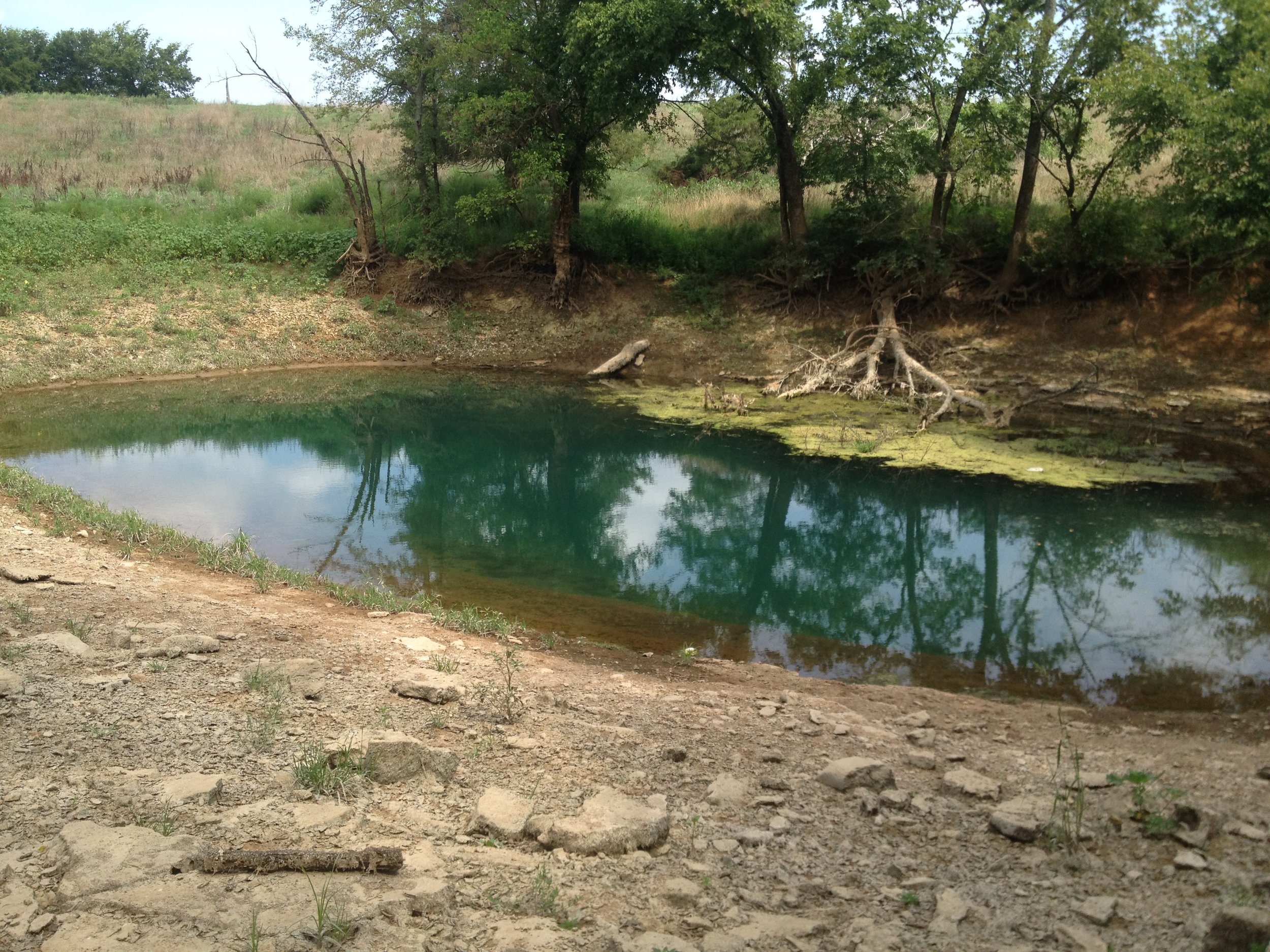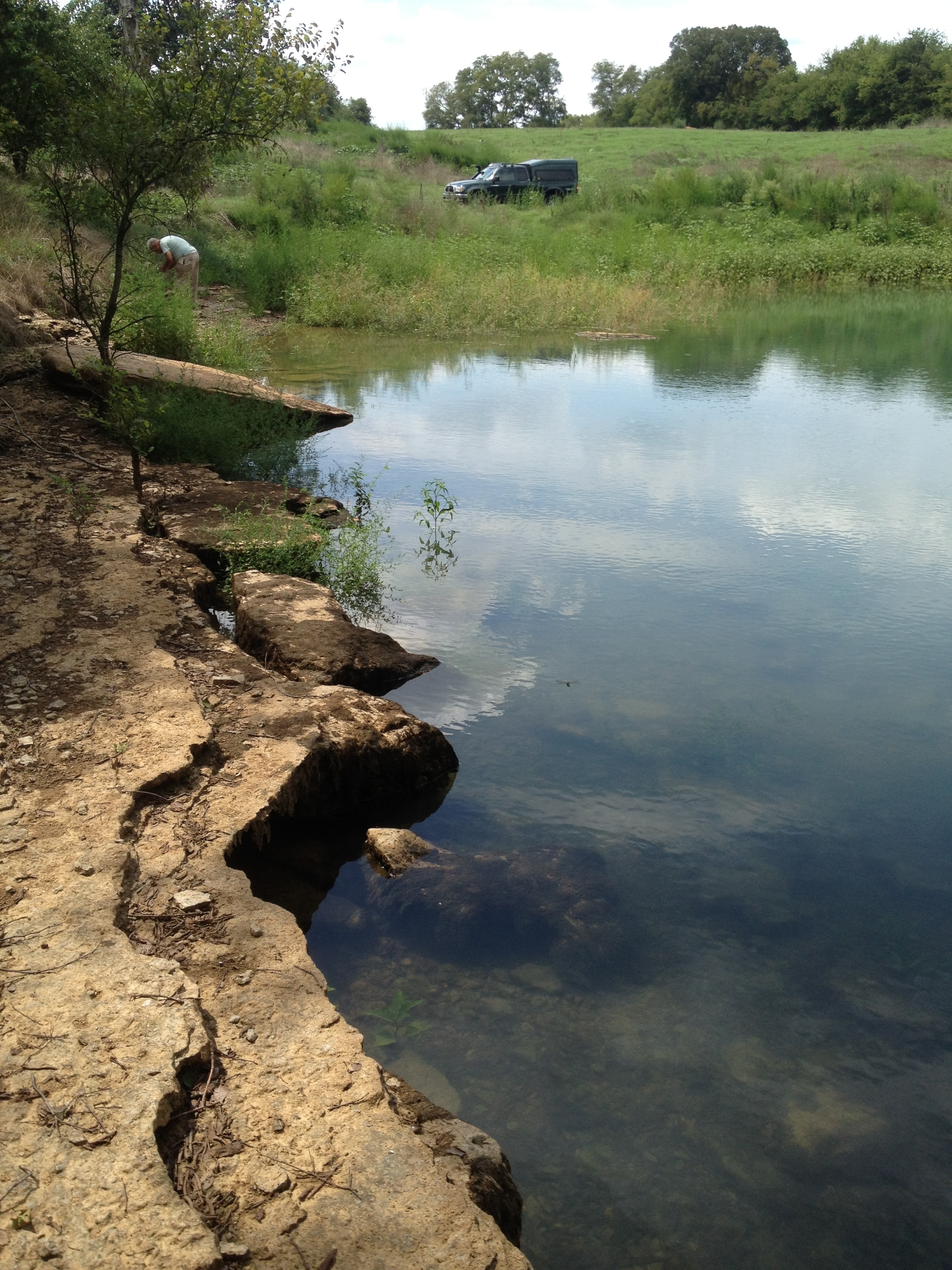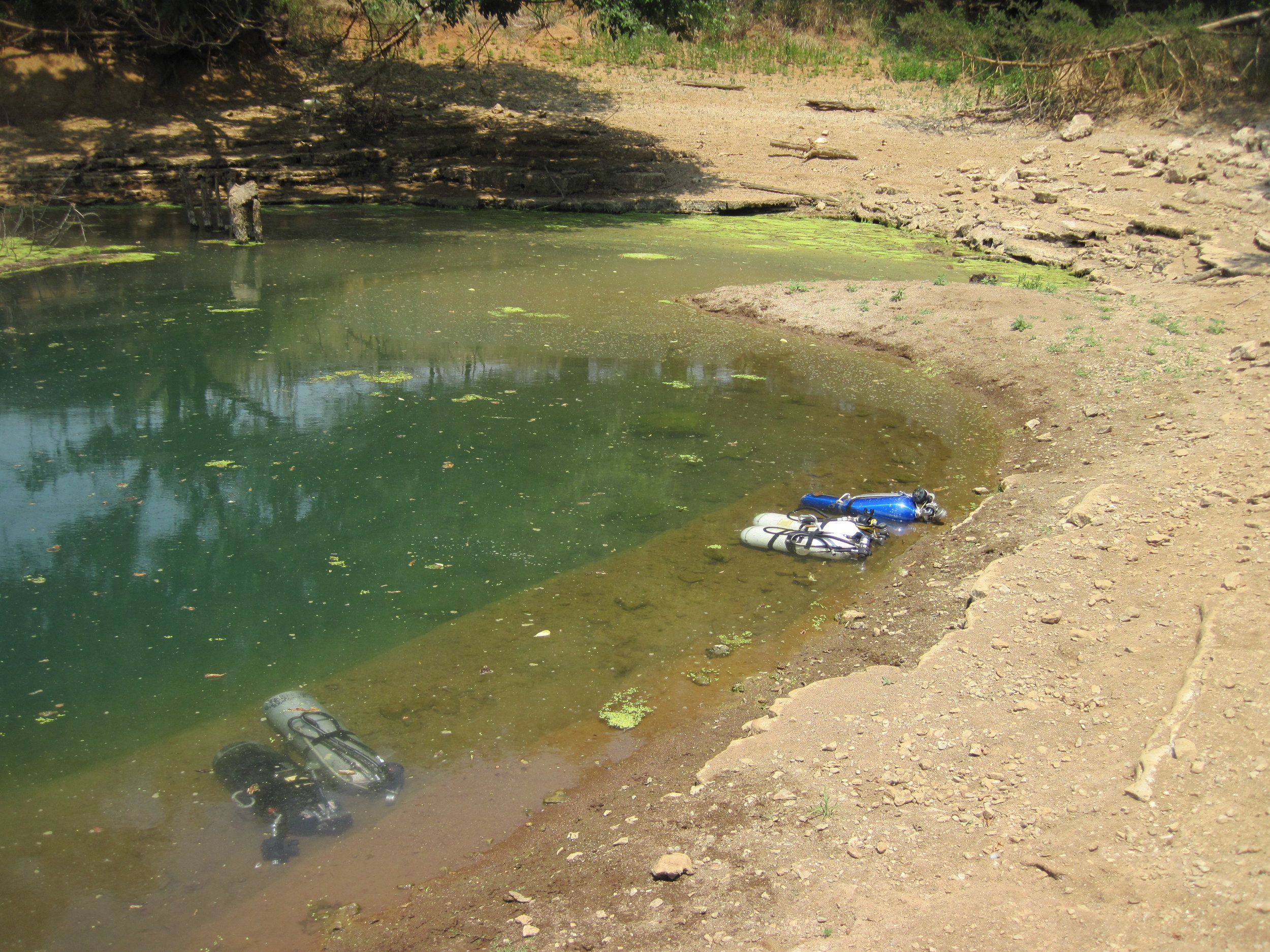Cow Crap is the second longest underwater cave in Tennessee (behind Jasper Blue Spring.) Starting at the Cow Sink entrance, it goes downstream to Military Spring, and upstream more than 10,600 feet underneath Green Man Sink, which at one time it connected to. Access is temporarily suspended while the property ownership is changed.
Jason and Chrissy at Cow Crap in good conditions!
Here is an article about the exploration, posted on the Cave Diver's Forum:
Drought may not be good for crops in Tennessee, but it sure is good for Cave Diving. We have been exploring and surveying the Cow Crap Cave System for more than a year and a half, and in that time have only managed 5 survey dives, where the conditions where good enough that we could see more than a few feet in the cave. This year, in 2012, Tennesse is beset with record temperatures and record low rainfall, setting the perfect conditions for diving at Cow Crap. The system is normally shallow, predominantly in the Ridley limestone, 50-60 feet below the generally flat corn fields and highways above. The entrances have been dye traced to other sinks in the area, and the whole system is believed to drain a very large area through multiple surface infeeders. This shallow and rapid recharge means that the system is impacted by every small thundershower that crosses the recharge area, and good visibility one day may be, and frequently is, gone the next. The main entry point, MTSU Karst Window, is true to its name and has a spring and siphon passage entrance on either side of a typically greenish pool. The water level can vary as much as 20 vertical feet at the karst window- During wet seasons, the water level is high in the trees, with millions of gallons of surface drainage flowing through the karst window. In diving season, the water level drops to expose limestone bluffs all around the sinkhole, and eventually exposes an old wooden fence which once divided the sink, buried in the sand bottom of the pool. When the fence is exposed, the flow is almost non-existent throughout the system. The water can drop so low as to completely isolate the upstream and downstream sides of the pool, exposing the brownish sandy bottom, but in the furthest reaches of the cave, there is still a whisper of flow- indicating that not all of the water crosses through the karst window.
The exploration team consists of the usual few core Tennessee cave divers- Marbry Hardin, Chrissy Richards and Jason Richards, and on occasion, Donald "Skip" Kendrick from Middle Tennessee State University will join us on a dive. Marbry and Skip were responsible for laying the first line in the upstream cave, and explored the cave to approximately 1100 feet from the entrance, and sort of stalled there. Marbry was also involved in the early exploration of the downstream, and later participated in the unsurveyed connection of Military Spring with Jason Richards in April of 2010. Within days of the connection to military, rains pumped water into the cave system, visibility dropped to inches, and the cave became undiveable. The cave wouldn't clear again until late into September of 2010.
The second week of September, Chrissy and Jason made exploratory dives into the cave. Though the visibility wasn't more than 5 feet, they traveled approximately 1000 feet upstream and pulled line out of the ever-shifting sand dune floors in preparation for more diving later in the month, should conditions continue to improve. By the 20th, the conditions were good enough for exploration, and Jason made the first solo exploration dive into the upstream, to try to extend the reaches of the cave. None of the upstream passage had been surveyed up to this point, so the mission for the dive was to survey to the end of the line, and if gas allowed, continue exploration. With a single stage bottle and sidemount 120s, Jason was able to survey the existing line and add 600 feet to the end, surveying on the way out.
Continuing on the improving visibility, Jason made another solo dive upstream on the 30th of September. This time, taking two scooters and a single stage bottle, he was able to add 1700 feet of new line in one dive by scootering to the end of the old line. The cave up to this point had resembled a low sewer tunnel, consistently 15 to 18 feet wide and five to six feet tall, but on this dive, Jason would encounter the first large room in the cave. The room seemed so large, that he would first lay a line into a smaller passage trending to the left of the main passage. He laid approximately 50 feet of line in this passage, and then returned to the room to explore the larger passage to the right. This passage continued, and led to the second large room in the cave, which contained the "Spire," a large triangular chunk of chert which had broken off the ceiling and imbedded itself vertically in the floor. The poor visibility initially caused some confusion, but Jason chose the passage which seemed to have clearer water, and drifted upward into another sewer passage, this time at only 20 feet of depth. Enabled by the shallow depths, Jason was able to place and survey 1,760 feet of new line, leaving the end of the line at only 34 feet. The spire room would continue to be interesting, as the cave would make an almost 90 degree turn from its previous direction. The sudden change in depth made everyone think that there might be another shallow passage on the opposite side of the room.
On the 10th of September, Jason would make one last dive before the cave would once again succumb to surface rain. Taking two scooters and two stages, he scootered to the end of the line, through the Spire Room, and into the shallow tunnel to begin laying new line. The shallow tunnel, slightly clearer than the rest of the cave, made exploration fairly easy, and Jason would eventually lay more than 2100 feet of line on this four hour dive. The passage changed from the familiar sewer tunnel to large, white walled vertical canyons approximately 1000 feet into the dive, reminiscent of the nearby Guy James cave. Unfortunately, this change in topography was paired with an increase in depth, and the shallow friendly cave would quickly turn into a deeper challenge, the end of the line tied off at a depth of 95 feet. The day after this dive, a large thunderstorm to the northwest of the cave would completely flush the visibility in the cave. When the team returned to dive the following weekend, they were greeted by a deep brown swirling siphon, the water howling across the karst window and into the downstream. The cave would remain dark for over a year and a half.
The first indication that Cow Crap might be diveable this year was during one of my airplane training flights. I had some spare time, and decided to fly over some of our favorite caves and see how they were looking from the air. To my surprise, I could see the bottom of the basin at Cow Crap. Though I was unsure if it was the sun, or the unique perspective, it was time to check back into diving at the cave. Some new politics had happened while we were away. Skip informed us that they land where the cave resides may have been sold back to the State, but was likely no longer the property of MTSU, though this could not be confirmed. Meanwhile, Marbry drove over to the cave, and confirmed that our nemesis, the gear licking cows, had indeed been removed, as well as the fences, and someone had planted corn over the cow fields. He also told us that the pool looked fantastic. Chrissy and I immediately made plans to come down and dive. Though Chrissy and I had been spending significant time on our other project cave, Jasper Blue Spring, the opportunity to dive Cow Crap was not to be missed, as it was so rarely diveable. Chrissy and I decided that our first dive would have to be the downstream, to repair lines, and survey the passage from Military Spring back to the Karst Window. Technically misnamed, Military Spring is itself a karst window, with both and upstream and downstream entrance on the floor of a large cavern area- which in flood is completely submerged and flows out the entrance into a surface creek, hence the name. But on today's dive, the room would be half empty, showing its impressive dimensions, and beckoning with the as yet unfound downstream siphon passage. On the 1st of July 2012, Chrissy and I entered the downstream with a single stage, knowing that the connection was something around 1800 feet of passage, and at its deepest, only 60 feet deep. We spent a significant amount of time repairing line shredded by the high flows racing through the sharp siphon passage, and buried below shifting dunes. Eventually we emerged at the cavern room of Military Spring, surprised to see how large it was, as the last time I was there, Marbry and I had poked our heads out the small entrance hole, the water being almost 10 feet deeper, and we were completely unaware how large the room behind us was. Once in the room, Chrissy and I turned and began our survey out.
With the survey of all existing lines finally complete, it was time to carry on with the exploration. On the 7th of July, Marbry, Chrissy and I got in the water with the intent of them going downstream to put line in suspected side passages (we had believed that Military Spring was not actually on the trunk passage, but a side passage) and I would go upstream with the rEVO rebreather to continue the exploration. One problem after another (I had forgotten the survey book, forgotten my drysuit socks, the mounting strap for the rebreather to my sidemount harness was STILL too short, and finally the offboard addition connector was leaking) caused me to call my dive at the surface, before it even got started. Marbry and Chrissy went on their dive as planned, and came back with the perplexing news that all of the places we had thought were side passages in the downstream were just larger areas of passage, and that all of the flow did indeed seem to go through the room at Military Spring. This was interesting news, but a little surprising, as both Marbry and I swore that we saw side passages at a couple of places in the passage. The unfortunate part was that without access to Military Spring (the landowner doesn't want divers) and most of the passage being fairly low and tight, scootering is probably unlikely, and the rebreather certainly wont fit. Through some miscommunication, Chrissy and Marbry turned the dive and never checked the rest of the Military Spring room, probably deciding to leave the virgin booty for me.
On the 8th of July, I came back to try to make the upstream dive. I spent the rest of the day before making the three hour round trip to the house to make rebreather repairs and pick up the missing equipment, so that I would be prepared for diving on Sunday. Marbry met me the next morning at the spring at 7AM, in hopes of getting into the water prior to the sun cresting the trees around the sink and causing heat stroke while I put on my drysuit, heavy weight underwear and heated vest. I arrived early and got all of the gear into the water just as Marbry showed up to assist. He helped me gear up in the water, and soon after I started the long scooter commute through the cave. With the Viper scooter on medium speed, I quickly navigated the front of the cave with its lower visibility, and brown stained guide line disappearing amongst the thin horizontal layers of chert along the brown walls. The usually coarse grained sand floor had picked up a thin layer of silt that moved around every time I stopped to repair a placement, or pull the line up out of a sand dune. Soon, I was at the room with the downstream T in the line. I had forgotten about this T, laid almost a year and a half prior, and was initially confused by its presence. I decided that since I was there to survey, and I was unsure which one was the main line, I picked the left passage to check. I tied off the scooters at the T, and swam down the line. Of course it ended in about 50 feet, but to my surprise, I could see another line on the other wall of the same passage. I quickly surmised what had happened: In the lower visibility on my last dive here, I had thought that there were two passages, but in reality I had laid line down each wall of the same passage. I retreated to the T, marked it appropriately with line arrows, and collected my scooters.
I continued to the Spire room, and considered checking the high shallow lead while I still had line, but opted to continue along the main line to see where it went instead, judging that the end was the more difficult lead to close. After an hour I reached the end of the line, to find that it had broken off the final tie-off. I found the line wrapped around a chunk of chert buried in the sand in the middle of the passage. After tyeing off a new reel to the end of the old line, I dropped the scooters at the new tieoff, adjusted the gas mix in the rebreather, and swam off into the virgin passage. The passage quickly reverted back from the nice vertically oriented canyons to the standard sewer tunnel, and continued nearly directly west. After about 20 minutes, piles of breakdown began to pile up in the center of the passage. The breakdown was strange, however, instead of large blocks, the breakdown consisted of large piles of thin flakes that had obviously fallen from the ceiling. Likely, this was caused by construction of the highway above the cave, which by this time, I was certainly under. As the breakdown got higher and higher, I began to worry that I might not be able to get past the breakdown, with the large rebreather on my back. Fortunately, I was able to weave back and forth from one side of the passage to the other and wind my way past the breakdown. On the far side, the passage continued again in the sewer tunnel type passage until I finally ran out of line in my second reel. Finding a large stick (from where?) I shoved the stick in the deep silt and made my final tieoff in the center of the passage, ready for the next exploration dive.







